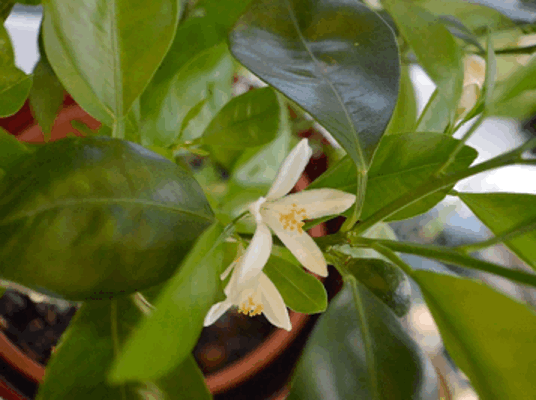This is one of our Top 20 most popular articles based on customer feedback and engagement. Originally published in July 2019, it has been updated with new images and product links. As always, please leave us your comments below!

Bringing tropical greenery indoors invites warmth, life, and oxygen to your space. With its lush foliage, perfumey blooms, and delicious fruit, citrus is one of the most rewarding families of plants to incorporate into your home. Growing citrus is not difficult when you understand its basic requirements.
- Light: Citrus plants need 6-8 hours per day of bright light to thrive. A south or west-facing, unobstructed window will provide the right amount of light for most citrus trees. If you can’t provide enough natural light for your citrus, supplement with a full spectrum lighting setup. This could be a single compact-fluorescent bulb or one with a larger footprint for multiple plants.
- Temperature: Citrus is content being outdoors when temperatures are consistently 50º F and above, but will need to be brought inside when temperatures drop below that line. When transferring citrus outside you will want to provide some shade protection against hot, midday direct sun to prevent the leaves from burning. A heated greenhouse or grow tent is a great environment for growing citrus if available.
- Humidity: Citrus enjoys humidity which can be a challenge indoors both with air-conditioning and heating sources. Therefore, another benefit to citrus being outdoors is that the ambient humidity is often higher. When indoors, a humidifier will help keep the foliage lush and will reduce stress on the plant which helps to ward off insects.
- Watering: Citrus thrives when the soil is moderately moist but not soggy. The best way to maintain proper moisture levels is to use a well-draining soil such as Happy Frog or Coast of Maine Cactus and Succulent Soil; dense soil can be lightened by adding perlite. Over-watering will turn leaves yellow and can rot the roots while under-watering will result in leaf and fruit drop. When outdoors, be sure the pots have proper drainage and position your citrus away from direct rainfall.
- Fertilizing: Citrus trees are heavy feeders therefore, a consistent fertilizing regimen will keep your plants happy and productive. A top dressing of granular slow-release fertilizer for acid-loving plants such as Happy Frog Acid Loving Fertilizer, Happy Frog Citrus and Avocado Fertilizer or Fox Farm Marine Cuisine Fertilizer will provide primary plant nutrients as well as a full range of important micronutrients. Be aware that most growers add fertilizer pellets at the nursery so wait to add fertilizer for several months after purchasing or add when repotting into new soil.
- Repotting: Repot citrus every 1-2 years going up only one size larger than the current pot (example: go from 10” to 12” diameter). Going into a pot that is too large will allow for too much moisture in the soil for the root ball to absorb which can cause root rot. Terra cotta clay pots are great for citrus as they breathe and allow soil to dry faster than glazed or plastic pots.

- Pests: Like all greenery, citrus plants can attract unwanted pests. The most common pests found on citrus are spider mites and scale, as well mealy bug and aphids on occasion. Alternating treatments of Safer insecticidal soap and Horticultural oil applied every other week in fall and winter is effective in keeping plants pest-free. For spider mite infestations, we recommend treating with rosemary oil-based SNS217 or Green Cleaner. Pest issues are typically worse when plants are indoors because they don’t get the protection of natural predators, although they may encounter a slug. Sluggo Plus, sprinkled around the base of the plant, will eradicate these critters.
- Pruning: You can prune your citrus trees at any time to maintain their shape and balance but be careful not to remove more than 25% of the foliage in one session. A dwarf variety will naturally keep a short, bushy growth pattern. If the plant has been grafted, always prune from below the graft to ensure the fruit-bearing capacity is not affected.
- Pollination: Fruit typically sets in the spring and summer, which then takes 6-8 months to ripen. Therefore, they will be ready to harvest and enjoy in late winter or early spring. Most citrus trees are self-pollinating, with both male and female reproductive parts contained in each flower. The exception to this is some varieties of tangerine that are self-sterile and need another tangerine variety for pollination.

Citrus trees can provide you with years of cooking fun, providing fruit for lemon curd, lemon crepes, preserved lemons, marmalades, bitters, key lime pies, sorbets, and countless other desserts, condiments, and cocktail fixings. Contact your local shop to find out what varieties and sizes are available now! Fifth Season Gardening is your source for organic soils, nutrients, lighting needs, and expert advice to make your indoor gardens flourish year-round!


Leave a Reply